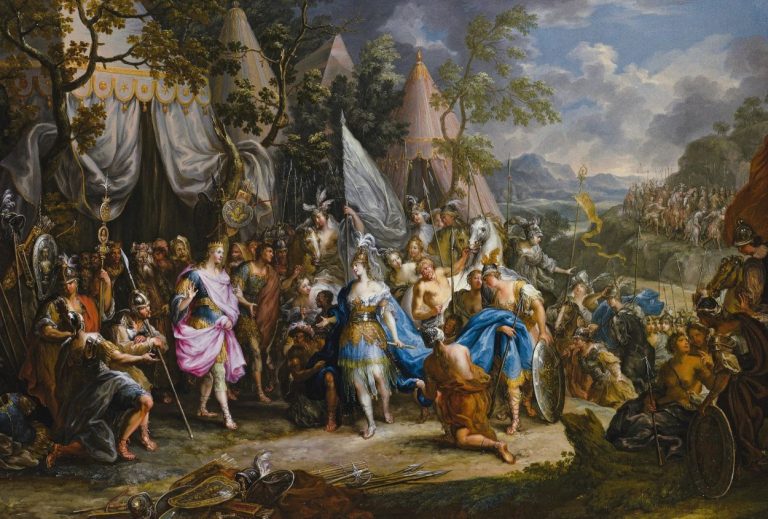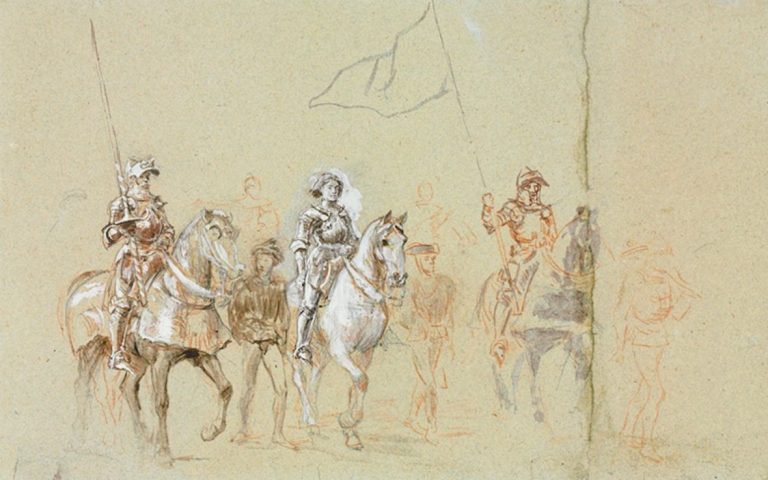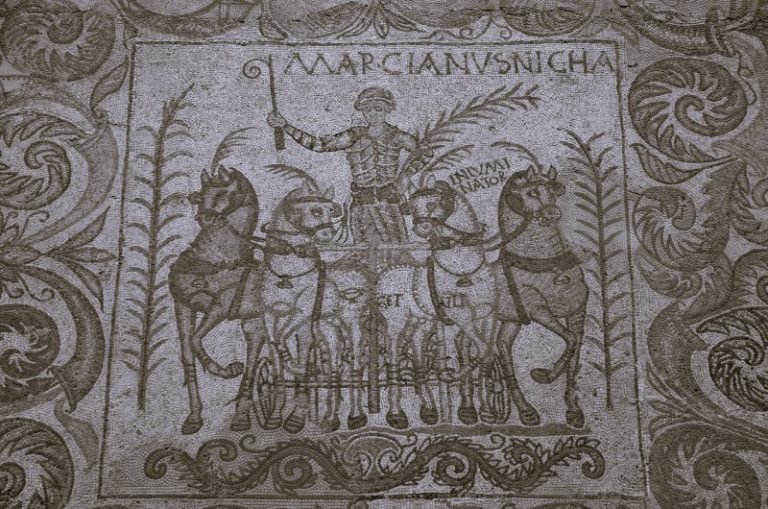
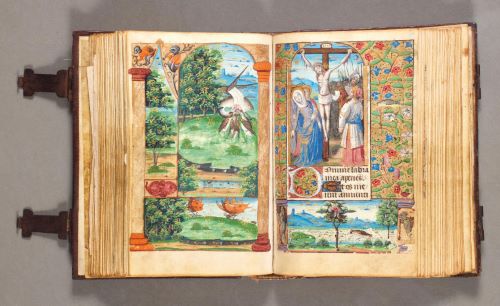
The commercial and cultural energies of London necessarily shaped some of the characteristics of its reading public.

By Dr. Julia Boffey
Professor Emerita of Medieval Studies
Queen Mary University of London
The reading matter available to members of prosperous lay households in late medieval London has attracted productive attention in a number of recent studies. Some of these have foregrounded the range of favoured texts, which included chronicles in the Brut tradition, poems by Chaucer and his successors and works of spiritual instruction and practical advice in both prose and verse.1 Other investigations have concentrated on the production and material features of manuscripts available to London readers, looking, for example, at common-profit collections, at anthologies composed of distinct booklets and at the personnel at work in the book trade.2
The distinctive commercial and cultural energies of London necessarily shaped some of the characteristics of its reading public, a significant proportion of whom were prosperous, educated laypeople keen to buy and in some cases commission both manuscripts and printed books. The interests of this sector have been explored by, among others, Caroline Barron, who has paid special attention to London merchants and to the works owned and read in their households.3
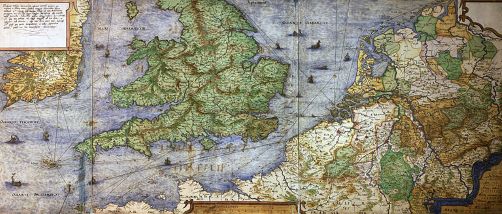
The surviving manuscripts that can be associated with this mercantile milieu are in many cases compilations of several works, sometimes the product of assembling separate booklets or fascicles.4 MS. HM 140 in the Henry E. Huntington Library in San Marino, California, is one such collection.5 Among its diverse contents are some works likely to have interested London merchants and prosperous householders: The Libelle of English Policy, for instance, dealing with commercial regulation and trade routes; and some Advice to Apprentices, aimed at the junior members of mercantile households.6 Descriptions of the compilation have indicated other connections to London in the form of various of the names inscribed in it.7 Since the manuscript as it now exists was compiled from distinct units, however, some careful analysis is needed in order to establish precisely how much of it might have originated in London or have been in the hands of London readers. This chapter will attempt an account of these matters as a prelude to exploring the appeal of some of the manuscript’s contents and extending what is known about the identities and affiliations of the individuals whose names are recorded in it.
Opinions have differed about the number of units brought together to form the manuscript as it now exists.8 The first of the sections (current fos. 1–92), made up of six gatherings, each constructed of paper with inner and outer strengthening bifolia of parchment, is mostly taken up with a copy of Lydgate’s Lives of SS. Alban and Amphabell (fos. 1–67).9 The rest of this section is filled with shorter poems by Lydgate and Chaucer, almost all explicitly oriented towards the cultivation of Christian virtues: Chaucer’s Clerk’s Tale, seemingly offered here as a parable about the virtue of constancy and rounded off with his short poem, ‘Truth’; Lydgate’s Prayer upon the Cross; and finally three more Lydgate items: ‘Midsomer Rose’, ‘Song of Vertu’andthe first section of his Testament.10 Only Chaucer’s Complaint of Anelida, a love complaint here extracted from the narrative framework in which it is sometimes found, interrupts what seems an explicit concern with cultivating properly devout and virtuous conduct.11 The likelihood that this unit of the manuscript originally had an independent existence, perhaps in an unbound state or in a simple and flimsy wrapper, is suggested by its very grubby opening leaf and the fact that the last leaf of its final gathering has been cut away, perhaps because it was damaged.12
This section offers no clues about its place of origin. It has some of the features of a planned anthology made up of gatherings of uniform size and structure and copied by scribes who worked in collaborative stints. As has been noted, though, the scribal collaboration becomes erratic towards its conclusion; and there may be grounds for supposing that this section was not produced in a commercial context in a centre such as London but more likely in a household or community of some kind where a number of resident scribes were able to share small stints of copying.13 Some descriptions of the manuscript have tentatively suggested that this section might be identifiable as the ‘newe boke of Inglisse, the which begynnyth with the lyffe of Seynt Albon and Amphiabell and other mony dyvers lyfez and thynges in the same boke’, bequeathed in 1459 by Sir Thomas Chaworth of Wiverton (Notts.) to his relative Robert Clifton; but, as has been recently noted, the watermarks in the paper of this section of MS. HM 140 suggests manufacture well into the second part of the fifteenth century, after Chaworth’s death in 1459.14 The hands also seem datable to the later fifteenth century. It remains unclear where this part of the manuscript originated and when exactly it was brought together with the other booklets with which it is now bound.
Immediately following this section in the manuscript’s current binding is a unit made up of three paper gatherings (fos. 93–123), all differently sized. A secretary hand different from any of the hands in the preceding section, although seemingly not far from them in terms of date, has copied a verse Life of Job onto some of the leaves (fos. 93v–96v), but most remain blank apart from some added notes.15 If there was ever a plan to insert further contents into this section it was never implemented. Possibly because the Life of Job seems somehow to echo Lydgate’s Lives of SS. Alban and Amphabell in the preceding part of the manuscript, some commentators on MS. HM 140 have assumed that the first two sections of the manuscript were connected from an early point.16 But this is unsupported by any evidence of shared paper stocks or scribes, or by the pattern of later annotations entered by particular individuals into both of these two parts. On the other hand, there are persuasive reasons for supposing that the Life of Job section was from an early stage associated with the third and currently final part of the manuscript, an enormous single paper gathering (fos. 124–70) containing items copied in several different hands. These include The Libelle of English Policy and Advice to Apprentices, both in verse; the story of Apollonius, in Latin prose; an English prose life of St. Ursula and the 11,000 virgins; and some short prose items of spiritual instruction. This final large gathering and the Life of Job section contain annotations in the same early sixteenth-century hand (on fos. 98 and 167, for example); and the paper of the outer bifolium of the large final gathering is of a stock that matches some of the paper in the Life of Job section. Both would therefore seem to have been together from an early stage. Since these are the sections containing annotations that make reference to Londoners, it is worth considering if and how their contents may reflect identifiably London-centric interests.
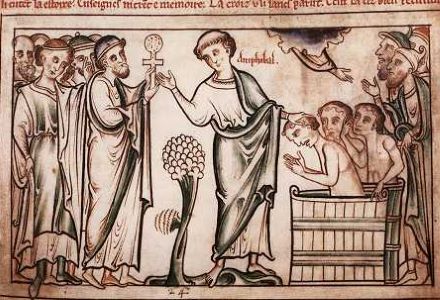
The longest item in the large single gathering forming the third section is The Libelle of English Policy, a libellus or ‘little book’, apparently compiled in a series of versions that came into circulation between late 1436 and a date sometime after June 1441 and dealing in over 1,000 lines of verse with English trade with the countries of Europe. Its concern with Anglo-Burgundian relations and the need to safeguard the English stronghold of Calais suggests that it would have been of immediate interest to a merchant audience; and indeed the work seems to have retained its appeal over many decades, well beyond the set of circumstances which prompted its composition. Notes or other forms of evidence in five of the fifteen complete or nearly complete surviving manuscripts point to owners from mercantile circles with London connections; and the copy in MS. HM 140 may be one further copy from such a milieu.17
The short poem now known as ‘Advice to Apprentices’ (fos. 167v–168) is even more explicit in its address to members of urban households.18 Offered as ‘doctryne’ for ‘children and yong men’ learning a craft in a master’s urban household, these instructions counsel predictable forms of good behaviour: early rising; cleanliness; good table manners; punctual attendance at work; and the cultivation of properly humble and respectful conduct towards master and mistress. The perils of city life loom threateningly in its advice to ‘flee suspeciows weyes’ and bad company and to avoid the forms of riotous living that involve cards, gaming, swearing and lechery. In its recommendations to ‘Lyve with your felisship peisibly’, ‘By and selle truly’, ‘Gette noo goode vntruly’ it nods explicitly to the mercantile milieux for which the young apprentice readers were being shaped. No other copy of this poem has survived and it could well be a one-off, brought into being by someone conscious of the need for an easily memorable and carefully targeted code of conduct for urban youth. The text is based on a widely circulating, endlessly adaptable set of instructions known as the ‘Precepts in –ly’, usually taking the form of a rough list of one-line nuggets of advice and in many instances roughly jotted down by manuscript readers who used some inviting empty space to record injunctions probably often learned by heart. Although there is considerable variation across the different surviving versions, particularly in relation to length and to devotional or secular focus, no other surviving text targets an apprentice audience. It seems possible that this version, carefully wrought in six-line stanzas, was conceived specially for a particular community, household or group.
In her exploration of what London merchants read, Caroline Barron has drawn attention to the prominence of copies of the Legenda aurea among books mentioned in bequests or surviving with notes of early ownership.19 The inclusion of an English account of the life St. Ursula and the 11,000 virgins translated from the Legenda in the third section of MS. HM 140 may reflect this taste. Stories from the Legenda had a wide circulation in English in the context of the South English Legendary, a verse translation dating, in its earliest form from the late thirteenth century, and the fifteenth-century prose Gilte Legende, based on the French of Jean de Vignay. The narrative in MS. HM 140 was not taken from either of these but represents an independent translation of the life of St. Ursula that survives in only one other witness, Southwell Minster MS. 7, where it accompanies John Mirk’s Festial and a selection of other saints’ lives.20 Studies of the cult of St. Ursula in England have drawn attention to the confusion of the legend of Ursula the virgin martyr with a story recounted in Geoffrey of Monmouth’s Historia regum Britanniae of the British woman who perished with her female companions en route to Brittany, where she was to marry Prince Conanus.21 The gradual elision of the two stories came to give Ursula special status as a British saint, addressed in the fifteenth century by Lydgate in a prayer as one of the company of ‘Brytoun martirs, famous in parfitnesse’ and celebrated in early Tudor spectacle and pageantry.22
MS. HM 140’s life of St. Ursula concludes with a verse stanza advising how to secure grace with the saint’s help, some Latin versicles and responses and a Latin prayer, all perhaps suggesting address to readers somehow actively involved in Ursula’s cult.23 During the fifteenth and early sixteenth centuries St. Ursula’s following was especially strong among merchants whose activities gave them links with Cologne, the location of both her tomb and important relics. The London church of St. Mary Axe (also known as St. Mary Pellipar) near Leadenhall Street, whose patrons were the Skinners’ Company, was dedicated to her; and the church of St. Lawrence Jewry near the Guildhall had a Fraternity of St. Ursula, members of which were among the many mercers who lived in this area (a copy of a printed indulgence from c.1520 for confraternity members survives).24 Early sixteenth-century records of pageants of St. Ursula, one of which was the responsibility of members of the Drapers’ Company, suggest that her story was well known; and the inclusion of her legend in MS. HM 140 may reflect acquaintance with performance as well as with narrative accounts. The manuscript’s verse Life of Job has recently been analysed by Cathy Hume as ‘written to accompany mimed action of a fairly elaborate kind’, perhaps at a guild feast, and it is tempting to imagine that St. Ursula’s legend might have been celebrated in a similar context.25
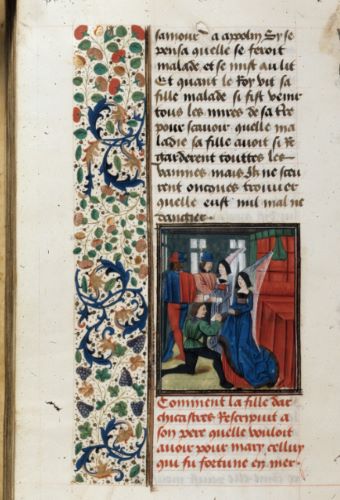
The other narrative copied in this section of the manuscript, the Latin Apollonius of Tyre, shares with the genre of the saint’s life a concern with faith and virtuous conduct in the face of vicissitudes. Medieval references to the story, which had a wide circulation in Latin and in many European vernaculars, suggest that it was thought of variously as a romance, a history and an exemplum, or indeed as an amalgam of all three.26 It presumably came the way of the compilers of MS. HM 140 as a free-standing tale, although by the later fifteenth century its reputation had been increased by its inclusion among the exemplary stories collected in the Gesta Romanorum, a tale collection with a wide European circulation.27 Its appearance in MS. HM 140 may also owe something to the fact that it was one of the earliest narratives to circulate widely in printed form, with free-standing Latin versions available by the very late 1460s and translations into various European vernaculars appearing in subsequent decades (testimony to some sense among printers that it would be a commercial success); it also had a wide printed circulation in its context in the Gesta Romanorum.28 Thematic connections between Apollonius and the Life of St. Ursula are not obvious, beyond their shared inclusion of sea journeys, but it may be significant that MS. HM 140’s version of the life of St. Ursula is shaped to include a heavenly marriage between Ursula and her earthly suitor, an element perhaps reflecting the family reunification that concludes Apollonius’s story.29
The collection of short prose items that concludes the final section of MS. HM 140 serves to consolidate its generally pious flavour. Copied here in several different hands, all the items survive in other copies. The so-called Profits of Tribulation circulated widely, surviving in at least fifteen other manuscripts, and is found in the company of other, longer works of religious instruction for laypeople.30 An item on The Benefits of Reading the Psalter survives elsewhere, not only in the manifestly pious context of books of hours: it also made its way into a collection of recipes and charms.31 The prose text known as Seven Things Necessary for Pardon, evidently some form of advertisement for the Syon pardon, survives in another copy, one with demonstrable London connections: Oxford, Corpus Christi MS. 237.32
Even though the contents of the second and third sections of MS. HM 140 may indicate London connections, the scribes and earliest owners left no obvious information about their identities or places of residence. The number of blank leaves and the variety of different hands may indicate that the sections resided for some years in a place where different people could make additions as desirable texts became available: a household seems a likely possibility. Some of the added notes are precisely datable, however, and these supply information on the whereabouts of the second and third sections of the manuscript during the third decade of the sixteenth century. The researches of John M. Manly and Edith Rickert, who were primarily interested in the manuscript’s copy of Chaucer’s Clerk’s Tale, produced identifications of some of the individuals named in these notes and situated MS. HM 140 in the hands of readers associated with Henry VIII’s court and with the council of Princess Mary.33 The likelihood that such readers would have been interested in the manuscript’s contents, and especially in the poems of Chaucer and Lydgate, has proved attractive,34 but this account of the manuscript’s early history clearly needs some adjustment, since its Chaucer and Lydgate section may not have been conjoined to the other parts in the early sixteenth century. Nonetheless, the findings of Manly and Rickert can serve as the starting point for further investigation of the early readers or owners of the second and third sections of the manuscript, bringing into focus individuals connected to civic and company circles in London and also to some of the offices of the court.
One name that appears in both the Life of Job section of the manuscript and in its large final gathering is that of a ‘William Marshall’ (on fos. 98, 160, 166v, 167, 170v). On folio 167 Marshall’s name appears at the start of a note about a grievance concerning a sum of money, recording an incident of 9 December 1521 in which ‘Master Breges’ assured ‘John Skot’ that someone (probably the writer and hence Marshall himself ) ‘sholde ley & rote in presen’; the note goes on to recount that on 12 December Breges repeated the same words to ‘Nycolas Slendon’. While Manly and Rickert did not follow up Marshall, they identified ‘Master Breges’ as John Brydges, master of the wardrobe in 1521 and 1530, and ‘John Skot’ as John Skut, queen’s tailor.35 But although royal service may have been one element of the acquaintance between these individuals, it seems important not to overlook that they were also a group of Londoners associated by craft. John Skut, first recorded in 1519 as tailor to Katherine of Aragon, would indeed serve all of Henry VIII’s queens; but he was also a prominent merchant tailor, warden of the Company in 1527 and master in 1536.36 Nicholas Slendon, identifiable as a tailor of London at a date close to 1521, might well have known Skut through a company association and is documented as bringing an action for debt against William Marshall.37 The various individuals identifiable as ‘Master Breges’ include not only the king’s tailor, John Bridges,38 but also Sir John Bridges or Brugge, an important merchant and member of the Drapers’ Company, who served as an alderman and then as mayor in 1520 to 1521 and was a member of parliament; he was knighted in 1521 and on these grounds and those of his company role would have warranted the title ‘master’.39 Quite how William Marshall might have offended these people in 1521 is unclear. He describes himself in another note in MS. HM 140 as ‘armerar’ (fo. 98) and may have been the man described in records as a ‘wire-seller’ of London, who was in 1524 retained by the captain of a ship named the George ‘to serve in the war’.40
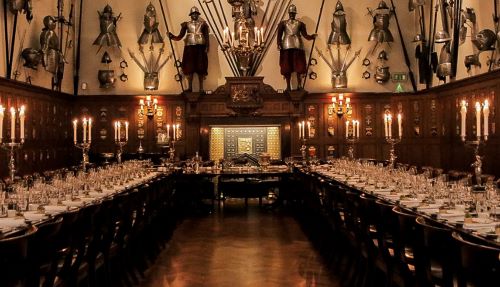
Armourers in London worked closely with other artisans and seem often to have identified with several different crafts during the course of their working lives; their affiliations depended partly on whether they were linen armourers, producing padded garments, or were concerned rather with the production of plate armour or chain mail.41 Many had close contacts with the royal wardrobe and it is hardly surprising to find Marshall in the circles of skilled craftsmen and merchants who worked in and around this office. Another note in MS. HM 140 in Marshall’s hand, undated, records ‘the … profettes of scavagyng gaderid [by] Robard Actun and wylliam marshall’, and ‘indytementes of vnlawfull pamentes chymneyis and pentesis don by the warmvthe queste and the aldyrman of the warde’ (fo. 166v).42 Marshall evidently undertook with an associate some local tasks relating to the enforcement of building regulations, under the purview of the wardmote; and was involved in ‘scavaging’, collecting the taxes imposed on foreign merchants who were obliged to find local hosts to act as their sponsors or brokers.43 His associate Robert Acton, identified by Manly and Rickert as a groom of the chamber by 1518 and a gentleman usher by 1528, was also a saddler, someone whose expertise and craft associations might have intersected with those of William Marshall; in this capacity Acton was king’s saddler from 1528 until his death in 1558, by which time he had advanced to a number of important positions.44 The names of the taxpayers on their list (John More, John Pachet, Richard Lyne, Thomas and Richard Alen, Nicolas Krystin and John Barton, along with ‘the cutlar nexte the flowirdeluse’ and ‘myghhell the ffrutrar’) include those of several other men who probably had connections similar to those of Acton and Marshall. Thomas Alen, for example, may have been the skinner who supplied lambskins to the royal wardrobe in 1510 and 1511; his will, made in 1524, refers to a son, Richard Alen, and names as a witness Richard Lyne, waxchandler: two of the names on Marshall’s list.45 The Nicolas Krystin on the list may have been the draper of that name who gained the freedom of the company in 1528 and was living in the parish of St. Michael Cornhill when he made his will in 1551.46
Chronologically the latest of the notes that Marshall added to MS. HM 140, the only one in which he describes himself as ‘armerar’ (fo. 98), records his delivery on 16 December 1527 of an ‘obligation’ and a ‘supplication’ signed by ‘my lorde of exetores hand & master doktar borneles hande’, together with a letter of attorney made by Richard Base, notary, to Richard Johnson, citizen, haberdasher and yeoman of the chamber to Lord Ferrers. The letters confirm that Johnson will receive at Bewdley, ‘or at ane othar plase were my lade prynses konsell lyethe’, a debt owed to Marshall by another armourer, William Carter, for a horse bought by Marshall on Carter’s behalf from Richard Welles of Stratford at Bow. As Manly and Rickert noted, some of the individuals named here were connected to the household of Princess Mary, specifically to the council in the Marches that was attached to it during the years that Mary spent in Wales.47 ‘My Lord of Exeter’ was John Veysey or Voysey, bishop of Exeter and at this point in charge of Mary’s council;48 ‘Master doktar bornele’ was Peter Burnell, Princess Mary’s almoner and treasurer;49 ‘My Lord feres’ was Walter Devereux, Lord Ferrers, steward of the household and councillor to the princess.50 But Marshall’s points of contact with Princess Mary’s council were men like himself: Richard Johnson, a London citizen and haberdasher attached at this point to Lord Ferrers’s household, and William Carter, another armourer.51
The other individuals named in the manuscript are not easily identifiable. Manly and Rickert suggested that the William Turner who left a Latin note (fo. 101) and wrote ‘This is master Turneris Boke testes John dolman Jamys Crock’ (fo. 170v) was master of the robes for Henry VIII; others have believed him to be the physician and botanist, also dean of Wells, who died in 1568.52 Another possible candidate is the William Turner, skinner, who died in 1533 and was commemorated in the church of St. Mildred Poultry, possibly to be identified as the man of the same name who served as groom of the toils (hunting nets) during the 1530s.53 The second part of the manuscript, at the very least, seems to have stayed in London for some years. Other notes made in informal sixteenth-century hands in this section include one that refers to ‘maister John hammulttone duyllyng in seint Jeyllis // parishe with ought cripulgat’ (fo. 123v);54 and another naming ‘Henry Diszell … Citiz. and stationer of London’ (fo. 114), who must have been the Henry Disle (fl. 1563–80) who was both a bookseller and a member of the Drapers’ Company.55 At some point before the late eighteenth or very early nineteenth century the three sections that make up the manuscript as currently compiled reached the collection of the antiquarian Richard Gough, himself a Londoner.56 It may be the case that some, if not all, of the component sections stayed in the vicinity of London during the intervening years.
London interests are marked in MS. HM 140 in a variety of ways. A number of items in what are now its second and third sections (notably the short texts of religious instruction) had an attested London circulation. Some of these contents, especially the Libelle of English Policy and the Advice to Apprentices, would clearly have been of interest to readers who were themselves merchant householders or were close to people from such circles. Others, such as the Life of Job and the Legend of St. Ursula and the 11,000 Virgins, would have interested those involved in the pious activities sponsored by London guilds and fraternities or taking place in London parishes. The raft of informal notes added to the second and third sections of the manuscript in the early sixteenth century, particularly those by William Marshall, indicate that by this point these sections were certainly in the hands of individuals with London connections. Some of the people mentioned in these notes were associated with the royal wardrobe and the household of Princess Mary; but they also seem likely to have been affiliated through the crafts they practised – as tailors, drapers, haberdashers, skinners, wire-makers; and through these same crafts to have forged connections with various of the offices of court. None of the notes left in the second and third sections of the manuscript comments on its contents; and it is quite possible that these contents went unread during the sixteenth century as annotators simply used available writing surfaces to record business matters they wanted to remember. As so often, it is impossible to know what kinds of value were attached by readers to the texts that passed through their hands. On the evidence of their content and known circulation, though, most of the texts brought together in the second and third sections of MS. HM 140 had a lively contemporary appeal in the late fifteenth century. Furthermore, the indications that texts were copied at different points by different hands into the third section suggest that this part, at least, enjoyed some kind of use. Whether readers continued to engage with the contents of the manuscript into the 1520s and beyond, as they used its empty space to record personal memoranda, is harder to fathom. Even though the saints’ lives and the instructions for pious living might have seemed unattractive reading during the decades of religious reform, other of the manuscript’s contents would not necessarily have lost their appeal. Parts of MS. HM 140 may have remained household reading for Londoners over many decades.
Endnotes
- See, e.g., L. M. Matheson, ‘National and civic chronicles in late fifteenth-century London’, in The Yorkist Age: Proceedings of the 2011 Harlaxton Symposium, ed. H. Kleineke and C. Steer (Harlaxton Medieval Studies, n.s., xxiii, Donington, 2013), pp. 56–74; Chaucer and the City, ed. A. Butterfield (Chaucer Studies, xxxvii, Cambridge, 2006); S. Lindenbaum, ‘London texts and literate practice’, in The Cambridge History of Medieval English Literature, ed. D. Wallace (Cambridge, 1999), pp. 284–309; M. Connolly, ‘Books for the “helpe of euery persoone þat þenkiþ to be saued”: six devotional anthologies from fifteenth-century London’, Yearbook English Stud., xxxiii (2003), 170–81; A. Appleford and N. Watson, ‘Merchant religion in fifteenth-century London: the writings of William Litchfield’, Chaucer Rev., xlvi (2011), 203–22; S. Kelly and R. Perry, ‘Devotional cosmopolitanism in fifteenth-century England’, in After Arundel: Religious Writing in Fifteenth-Century England, ed. V. Gillespie and K. Ghosh (Medieval Church Studies, xxi, Turnhout, 2011), pp. 363–80.
- W. Scase, ‘Reginald Pecock, John Carpenter and John Colop’s “common-profit” books: aspects of book ownership and circulation in fifteenth-century London’, Medium Aevum, lxi (1992), 261–74; L. R. Mooney, ‘Locating scribal activity in late medieval London’, in Design and Distribution of Later Medieval Manuscripts in England, ed. M. Connolly and L. R. Mooney (York, 2008), pp. 183–204; L. R. Mooney, ‘Scribes and booklets of Trinity College, Cambridge, MSS. R. 3. 19 and R. 3. 21’, in Middle English Poetry: Texts and Tradition: Essays in Honour of Derek Pearsall, ed. A. Minnis (Woodbridge, 2001), pp. 241–66; C. P. Christianson, ‘Evidence for the study of London’s late-medieval book-trade’, in Book Production and Publishing in Britain 1375–1475, ed. J. Griffiths and D. Pearsall (Cambridge, 1989), pp. 87–108; C. P. Christianson, A Directory of London Stationers and Book Artisans 1300–1500 (New York, 1990).
- C. M. Barron, ‘What did medieval London merchants read?’, in Medieval Merchants and Money: Essays in Honour of James L. Bolton, ed. M. Allen and M. Davies (London, 2016), pp. 43–70; C. M. Meale, ‘The Libelle of Englyshe Polycye and mercantile literary culture in late-medieval London’, in London and Europe in the Later Middle Ages, ed. J. Boffey and P. King (Turnhout, 1995), pp. 181–227; A. Moss, ‘A merchant’s tales: a London fifteenth-century household miscellany’, Yearbook of English Stud., xxxiii (2003), 156–69; A. F. Sutton, ‘The acquisition and disposal of books for worship and pleasure by mercers of London in the later middle ages’, in Manuscripts and Printed books in Europe 1350–1550: Packaging, Presentation and Consumption, ed. E. Cayley and S. Powell (Liverpool, 2013), pp. 95–114; K. L. Scott, ‘Past ownership: evidence of book ownership by English merchants in the later middle ages’, in Makers and Users of Medieval Books: Essays in Honour of A. S. G. Edwards, ed. C. M. Meale and D. Pearsall (Cambridge, 2014), pp. 150–77.
- For some examples, see J. Boffey and C. M. Meale, ‘Selecting the text: Rawlinson C. 86 and some other books for London readers’, in Regionalism in Late Medieval Manuscripts and Texts: Essays Celebrating the Publication of ‘A Linguistic Atlas of Late Mediaeval English’, ed. F. Riddy (Cambridge, 1991), pp. 143–69.
- The manuscript has been digitized in full: <http://cdm16003.contentdm.oclc.org/cdm/ref/collection/p15150coll7/id/19150> [accessed 23 July 2018]. The most recent description is by D. Mosser, A Digital Catalogue of the Pre-1500 Manuscripts and Incunables of ‘The Canterbury Tales’, 2nd edn. <http://mossercatalogue.net/results.php?location=&repository=&manuscript=Ph4&edition=&search=SEARCH> [accessed 23 July 2018].
- DIMEV 5509/NIMEV 3491 and DIMEV 976/NIMEV 596. See Meale, ‘Libelle’, for the Libelle’s London circulation (recently extended by an argument that, whatever its circulation, the Libelle’s author ‘is less obviously metropolitan than is often supposed’ (M. Bennett, ‘The Libelle of English Policy: the matter of Ireland’, in The Fifteenth Century XV. Writing, Records, and Rhetoric, ed. L. Clark (Woodbridge, 2017), pp. 1–21, at p. 6.
- The details in J. M. Manly and E. Rickert, The Text of ‘The Canterbury Tales’ (8 vols., Chicago, Ill., 1940), i. 433–8 are confirmed in C. W. Dutschke et al., Guide to Medieval and Renaissance Manuscripts in the Huntington Library (2 vols., San Marino, Calif., 1989), i. 185–90; and in Mosser, Digital Catalogue.
- The nineteenth-century binding (dated 1835 by Dutschke et al.) obscures much about the early bringing together of the manuscript’s component parts. For some analysis of the manuscript’s construction, see W. McClellan, ‘A codicological analysis of the quire structure of MS HM 140 and its implications for a revised ordinatio’, Text, ix (1996), 187–98.
- DIMEV 5966/NIMEV 3748.
- DIMEV 6414/NIMEV 4019; DIMEV 1326/NIMEV 809; DIMEV 6132/NIMEV 3845; DIMEV 3058/NIMEV 1865; DIMEV 663/NIMEV 401; DIMEV 3937/NIMEV 2464 (other excerpts from Testament were in circulation).
- DIMEV 4949/NIMEV 3670, placed here between the Prayer upon the Cross and Midsomer Rose.
- Gatherings 3 and 4 of this section have been bound in reverse order, which may also suggest that they were only loosely kept together for part of their early existence.
- W. McClellan, ‘The transcription of the “Clerk’s Tale” in MS HM 140: interpreting textual effects’, Stud. in Bibliography, xlvii (1994), 89–103. McClellan supplied an analysis of the hands (pp. 91–3) and noted a suggestion made to him by Ralph Hanna that ‘production features of the manuscript indicate that it might have been produced in a private household, not a commercial shop’ (p. 92, n. 7). Mosser noted linguistic forms characteristic of the central Midlands in some of the scribal stints (Digital Catalogue).
- G. Cole and T. Turville-Petre, ‘Sir Thomas Chaworth’s books’, in The Wollaton Medieval Manuscripts: Texts, Owners and Readers, ed. R. Hanna and T. Turville-Petre (Woodbridge and Rochester, 2010), pp. 20–9, at pp. 25–6.
- DIMEV 3551/NIMEV 2208. See G. N. Garmonsway and R. R. Raymo, ‘A Middle English metrical life of Job’, in Early English and Norse Studies Presented to Hugh Smith in Honour of his Sixtieth Birthday, ed. A. Brown and P. Foote (London, 1963), pp. 77–98; and C. Hume, ‘The Life of Job: Bible translation, poem or play?’, New Medieval Literatures, xviii (2018), 211–42. I am most grateful to Dr. Hume, who kindly allowed me to read her article before publication.
- See, e.g., S. Lerer, who reads the whole manuscript as a demonstration of ‘formal and thematic coherence’ (S. Lerer, Chaucer and his Readers: Imagining the Author in Late-Medieval England (Princeton, N.J., 1993), pp. 100–16, at p. 101); and L. Staley, who offers a more cautious assessment (L. Staley, ‘Huntington 140: Chaucer, Lydgate and the politics of retelling’, in Retelling Tales: Essays in Honor of Russell Peck, ed. T. Hahn and A. Lupack (Cambridge, 1997), pp. 293–320).
- Meale, ‘The Libelle’, pp. 206–27. The version in MS. HM 140, classified among those descending from one produced between (?)9 Dec. 1437 and 6 June 1441, has close relatives in Oxford, Bodleian Library MS. Rawlinson poet. F 32; and BL MS. Cotton Vitellius E X and Additional MS. 40673, all apparently of London provenance. Mercantile ownership has also been suggested for the copies in Boston Public Library MS. 1519; and London, Society of Antiquaries MS. 101.
- The only edition of this version is that in Reliquiae Antiquae, ed. T. Wright and J. O. Halliwell (2 vols., 1841–3), ii. 223–4. Other versions of the ‘Precepts in –ly’ include DIMEV553/NIMEV 317; DIMEV 560/NIMEV 324; DIMEV 4810/NIMEV 905.77; DIMEV 2415/NIMEV 1436.44; DIMEV 4444/NIMEV 2794.99; DIMEV 4810/NIMEV 3087; DIMEV4840/NIMEV 3102. There is useful discussion of the different versions in The Commonplace Book of Robert Reynes of Acle: an Edition of Tanner MS 407, ed. C. Louis (New York, 1980), pp. 393–4. Felicity Riddy explores some other works addressed to young members of urban households in ‘Mother knows best: reading social change in a courtesy text’, Speculum, lxxi (1996), 66–86.
- Barron, ‘What did medieval merchants read?’, p. 44.
- For an edition (with the Latin of the Legenda), see G. N. Garmonsway and R. R. Raymo, ‘A Middle-English prose life of St Ursula’, Rev. English Stud., n.s., ix (1958), 353–61. This article does not take account of the version in Southwell Minster MS. 7, on which see M. Görlach, ‘A second version of the Huntington prose legend of St. Ursula’, Rev. English Stud., n.s., xxiv (1973), 450–1; V. Edden, The Index of Middle English Prose. Handlist XV: Manuscripts in Midland Libraries (Cambridge, 2000), pp. 54–7; and S. Nevanlinna and I. Taavitsainen, St Katherine of Alexandria: the Late Middle English Prose Legend in Southwell Minster MS 7 (Cambridge, 1993), pp. 49–54. On versions of the life of St. Ursula, see W. Marx, ‘St Ursula and the eleven thousand virgins: the Middle English Legenda Aureatradition’, in The Cult of St Ursula and the 11,000 Virgins, ed. J. Cartwright (Cardiff, 2016), pp. 143–62. Dr. Marx kindly provided me with a copy of his chapter, for which I am most grateful.
- E. J. Bryan, ‘Ursula in the British history tradition’, in Cartwright, Cult of St Ursula, pp. 119–41.
- F or Lydgate’s prayer, see The Minor Poems of John Lydgate, ed. H. N. MacCracken (Early English Text Soc., e.s., cii and o.s., cxcii, 2 vols., London, 1911 and 1934), i. 144. Ursula’s role in early Tudor pageantry is discussed by C. Sanok, New Legends of England: Forms of Community in Late Medieval Saints’ Lives (Philadelphia, Pa., 2018), pp. 237–73.
- See further, L. S. Chardonnens and C. Drieshen, ‘A Middle English version of Saint Ursula’s prayer instruction in Nijmegen, Universiteitsbibliotheek, HS 194’, Stud. in Philology, cx (2013), 714–30 (the English stanza in MS. HM 140, DIMEV 1185/NIMEV720 is transcribed here on p. 727 and is also in Wright and Halliwell, Reliquiae Antiquae, ii. 224). The English verse life of St. Ursula commissioned by Lady Margaret Beaufort from Edmund Hatfield, monk of Rochester, and printed by Wynkyn de Worde c.1509 (STC24541.3) concludes with similar Latin material.
- On St. Mary Axe, originally dedicated to St. Mary the Virgin and St. Ursula and the 11,000 virgins, see A Survey of London by John Stow, ed. C. L. Kingsford (2 vols., Oxford, 1908), i. 160 and ii. 296; on St. Lawrence Jewry see A. F. Sutton, The Mercery of London: Trade, Goods and People 1130–1578 (Aldershot, 2005), p. 195. Sanok has much interesting information on ‘urban Ursulas’ and includes an illustration of the indulgence (printed by Wynkyn de Worde, STC 14077c.59, BL frag, C.18.e.2(33)) (Sanok, New Legends of England, pp. 247–50).
- Hume, ‘The Life of Job’, p. 236. In August 1523 the Drapers’ Company was responsible ‘for making of a newe pagent of Saynt Ursula’ (A. Lancashire, Records of Early English Drama: Civic London to 1558 (3 vols., Toronto, 2015), ii. 414).
- E. Archibald, Apollonius of Tyre: Medieval and Renaissance Themes and Variations (Cambridge, 1991), provides an English translation and a Latin text, the latter based on that of Historia Apolloni Regis Tyri, ed. G. A. A. Kortekaas (Medievalia Groningana, iii, Groningen, 1984). The European reception of the story is discussed by E. Archibald and by G. A. A. Kortekaas, ‘The Latin adaptations of the “Historia Apollonii regis Tyri” in the middle ages and Renaissance’, Groningen Colloquia on the Novel, iii. ed. H. Hofmann (Groningen, 1990), pp. 103–37.
- P . Bright, ‘Anglo-Latin collections of the Gesta Romanorum and their role in the cure of souls’, in What Nature Does Not Teach: Didactic Literature in the Medieval and Early Modern Periods, ed. J. F. Ruys (Turnhout, 2008), pp. 401–24.
- I ncunabule versions are listed in the British Library’s Incunabula Short-Title Catalogue <https://data.cerl.org/istc/_search> under Apollonius de Tyro and Gesta Romanorum [accessed 23 July 2018]. The earliest free-standing Latin printed version is from 1474, printed in Utrecht.
- On Ursula’s heavenly marriage, see Sanok, New Legends of England, pp. 252–4. Kortekaas noted that versions of the Apollonius story in the Gesta Romanorum usually conclude with a gesture towards a moralization, as customary in Gesta exemplary narratives (‘Latin adaptations’, p. 105). The text in MS. HM 140 ends with the family reunification, at a point equivalent to Archibald, Apollonius, paragraph 49 (p. 174), but has no moralization.
- ‘Here begynnyth a litell short Tretis that tellith howe that there were vj maistres’; see P. S. Jolliffe, A Check-List of Middle English Prose Writings of Spiritual Guidance (Toronto,1974), item 2c, for a list of manuscripts.
- London, Lambeth Palace, MS. 186 and London, Victoria and Albert Museum, MS. Reid 45; Oxford, Bodleian Library, MS. Ashmole 1447 (2). See O. S. Pickering and V. M. O’Mara, The Index of Middle English Prose. Handlist XIII: Manuscripts in Lambeth Palace Library, including those formerly in Sion College Library (Cambridge, 1999), p. 15.
- ‘Here folowen seven thynges whiche a man or womman must haue for to be able to gete pardon’ (Jolliffe, item E5). See K. A. Rand, ‘The Syon pardon sermon: contexts and texts’, in Preaching the Word in Manuscript and Print in Late Medieval England: Essays in Honour of Susan Powell, ed. M. W. Driver and V. O’Mara) Sermo, xi, Turnhout, 2013), pp. 317–49. MS. Corpus 237 includes (along with several saints’ lives and The Pilgrimage of the Soul) Lydgate’s Dance macabre,headed ‘The daunce of powlys’, and ‘The maner of offering in the cyte of london’; for a description, see R. M. Thomson, A Descriptive Catalogue of the Medieval Manuscripts of Corpus Christi College, Oxford (Cambridge, 2011), pp. 121–2.
- Manly and Rickert, ‘The Canterbury Tales’, i. 436–8.
- For the wider context, see, e.g., S. Lerer, Courtly Letters in the Age of Henry VIII: Literary Culture and the Arts of Deceit (Cambridge, 1997); and G. Walker, Writing under Tyranny: English Literature and the Henrician Reformation (Oxford, 2005), pp. 56–99.
- The identification of Skut (Manly and Rickert, ‘The Canterbury Tales’, i. 437) is supported by references in Letters and Papers, Foreign and Domestic, of the Reign of Henry VIII, ed. J. S. Brewer, J. Gairdner and R. H. Brodie (23 vols. in 38 (1862–1932) and in Privy Purse Expenses of the Princess Mary, ed. F. Madden (London, 1831), p. 266 for the years 1530–47. Breges or Bridges is taken to be the individual mentioned in Letters and Papers, iii (1). 502 and v. 320.
- S ee M. Hayward, Dress at the Court of Henry VIII (Leeds, 2007), p. 322; The Great Wardrobe Accounts of Henry VII and Henry VIII, ed. M. Hayward (London Rec. Soc., xlvii, 2012), pp. xxix, xxxv; and M. Hayward, ‘Skut, John (fl. 1519–1547), tailor’, ODNB <https://doi.org/10.1093/ref:odnb/93736> [accessed 24 July 2018].
- TNA, C 1/442/39: Slendon named as plaintiff in a case brought against William Michell of London, armourer, 1515–18; he is also named in C 1/442/38 and C 1/347/20.
- Hayward, who noted that he was in royal service from 1516 to 1559 (Dress, p. 322).
- See the History of Parliament biography by H. Miller at <http://www.historyofparliamentonline.org/volume/1509-1558/member/brydges-%28brugges%29-john-1470-1530> [accessed 23 July 2018]. A less likely candidate as ‘Master Breges’ is Walter Brydges, groom of the chamber to Princess Mary, 1525–37 (Madden, Privy Purse Expenses, index, p. 215).
- Letters and Papers, iv (2), g. 86 (3), 34. Other cases from 1520 to 1530 involving William Marshall are documented in TNA, C 1/547/12 (action against William Marshall by John Fardyng of London, merchant tailor, for an unpaid debt); TNA, C 1/546/83 (action by Marshall and Richard Moniam, draper, against a mercer and a merchant stranger); TNA, C 1/574/12 (action taken against Marshall by John Smyth, skinner, and [William?] Rogiers, wax-chandler, both of London); TNA, C 241/282/85 (action taken by Robert Smith, citizen and merchant, to reclaim a debt from Marshall). It seems unlikely that William Marshall, armourer, is to be identified with the William Marshall who was clerk to the chief baron of the exchequer in 1527 and in the 1530s a writer and translator of reformist works. On this individual, see A. Ryrie, ‘Marshall, William (d. 1540?), printer and translator’, in ODNB <https://doi.org/10.1093/ref:odnb/18153> [accessed 16 Jan. 2019]; D. E. Rhodes, ‘William Marshall and his books, 1533–1537’, Papers Bibliograph. Soc. America, lviii (1964), 219–31; and W. Underwood, ‘Thomas Cromwell and William Marshall’s Protestant books’, Hist. Jour., xlvii (2004), 517–39.
- M. Mercer, ‘Kings’ armourers and the growth of the armourers’ craft in early fourteenth-century London’, Fourteenth-Century England VII, ed. J. S. Hamilton (Woodbridge, 2014), pp. 1–20; B. Kirkland, ‘“Now thrive the Armourers”: the development of the armourers’ crafts and the forging of fourteenth-century London’ (unpublished University of York PhD thesis, 2015). Linen armourers were assimilated into the Merchant Taylors’ Company (M. Davis and A. Saunders, The History of the Merchant Taylors’ Company (Leeds, 2004), pp. 11–3 and 49–52). I am very grateful to Christian Steer for alerting me to relevant studies of armourers and to Elizabeth New for discussion of linen-armourers.
- ‘scavagyng’, collecting a toll on merchant strangers (OED scavage, n., 1); ‘pamentes’, pavements (OED pament, n., 1); ‘warmvthe queste’, wardmote inquest (OED wardmoot, n., compounds, C2).
- On these responsibilities of the wardmote, see C. M. Barron, London in the Later Middle Ages: Government and People 1200–1500 (Oxford, 2004), pp. 21–7, 247–8. For scavaging, see further S. Ogilvie, Institutions and European Trade: Merchant Guilds 1000–1800 (Cambridge, 2011), p. 173; and N. Middleton, ‘Early medieval port customs, tolls and control on foreign trade’, Early Med. Europe, xiii (2005), 313–58. It is possible, although less likely, that the term ‘scavaging’ here refers to the forms of street-cleaning for which local wards appointed ‘scavengers’ (Barron, London,pp. 125 and 262; E. Sabine, ‘City cleaning in medieval London’, Speculum, xii (1937), 19–43).
- Manly and Rickert, ‘The Canterbury Tales’, i. 37, citing Letters and Papers, iv, index. See Hayward, Great Wardrobe Accounts, pp. 215, 280; Hayward, Dress, pp. 27, 276, 332, 339–40; and the History of Parliament biography by D. F. Coros <http://www.historyofparliamentonline.org/volume/1509-1558/member/acton-robert-1497-1558> [accessed 23 July 2018].
- Hayward, Great Wardrobe Accounts, pp. 93–4, 106, 108–10, 124, 152; Thomas Allen ‘of the royal household’ is mentioned in Letters and Papers, iii. 50 (Jan. 1519). The will of Thomas Aleyn (TNA, PROB 11/21, fos. 200–200v) mentions his birth in the parish of St. Clement and arrangements for his burial in what had become his local parish of St. Martin Ludgate. A ‘Richard Alen’ is noted among those serving in the office of the beds at the Field of the Cloth of Gold (Letters and Papers, iii. 246).
- TNA, PROB 11/34, fo. 184r–v.
- D. Loades, Mary Tudor: a Life (Oxford, 1989), pp. 36–76 and (for a list of household members) pp. 348–51; W. R. B. Robinson, ‘Princess Mary’s itinerary in the marches of Wales 1525–1527: a provisional record’, Hist. Research, lxxi (1998), 233–52; J. L. McIntosh, From Heads of Households to Heads of State: the Pre-Accession Households of Mary and Elizabeth Tudor, 1516–1558 (New York, 2009), pp. 46–72; and J. L. McIntosh, ‘A culture of reverence: Princess Mary’s household 1525–27’, in Tudor Queenship: the Reigns of Mary and Elizabeth, ed. A. Hunt and A. Whitelock (New York, 2010), pp. 113–26.
- S ee N. Orme, ‘Veysey [formerly Harman], John (c. 1464–1554), bishop of Exeter’, in ODNB <https://doi.org/10.1093/ref:odnb/28262> [accessed 24 July 2018]; and Loades, Mary Tudor,pp.40–1.
- Called John Burnell by Manly and Rickert, ‘The Canterbury Tales’, i. 436, following a reference in Letters and Papers, iv (1), no. 2331; but see BRUO (to A.D. 1500), i. 316.
- S ee H. A. Lloyd, ‘Devereux, Walter, first Viscount Hereford (c. 1489–1558), administrator and nobleman’, in ODNB <https://doi.org/10.1093/ref:odnb/7567> [accessed 24 July 2018]; and Loades, Mary Tudor, pp. 39–41, 185.
- A ‘William Armourer’, possibly William Carter, is listed among those supporting the council in the Marches in 1525 (Loades, Mary Tudor, p. 351). Richard Johnson may be the citizen and haberdasher of the parish of All Hallows Barking whose will was proved in 1539 (LMA, DL/C/B/004/MS09171/010, fo. 336). William Marshall also made the note ‘Md that I william marshall hathe R of Thomas’ (fo. 170v) and was probably responsible for a series of informal memoranda about rental of a property (fo. 160).
- A. J. Kempe, Historical Notices of the Collegiate Church or Royal Free Chapel and Sanctuary of St. Martin le Grand, London (London, 1825), p. 113; Garmonsway and Raymo, ‘St Ursula’, p. 353; W. R. D. Jones, ‘Turner, William (1509/10–1568), naturalist and religious controversialist’, ODNB <https://doi.org/10.1093/ref:odnb/27874> [accessed 24 July 2018]; and the History of Parliament biography by T. F. T. Baker and A. D. K. Hawkyard <http://www.historyofparliamentonline.org/volume/1509-1558/member/turner-william-1512-68> [accessed 24 July 2018].
- The monument was noted by John Stow (Stow, Survey of London, i. 262). His will, made in 1536, is TNA, PROB 11/25/574. References to William Turner, groom of the toils, are in Hayward, Dress, p. 280 and Great Wardrobe Accounts, pp. 214, 280.
- It has not proved possible to identify a John Hamilton of the parish of St. Giles Cripplegate, but there may be a London connection for the name ‘Thomas ?masun’ (fo. 113v): Stow noted a monument to a draper of this name in the church of St. Giles Cripplegate (Stow, Survey of London, i. 299).
- See The London Booktrades: a Biographical and Documentary Resource <http://lbt.bodleian.ox.ac.uk/mediawiki/index.php/LBT/07877> [accessed 23 July 2018].
- S ee R. H. Sweet, ‘Gough, Richard (1735–1809), antiquary’, in ODNB <https://doi.org/10.1093/ref:odnb/11141> [accessed 24 July 2018]; and for wider context, R. Sweet, ‘Antiquaries and antiquities in eighteenth-century England’, Eighteenth-Cent. Stud., xxxiv (2001), 181–206.
Chapter 3 (55-70) from Medieval Londoners: Essays to Mark the Eightieth Birthday of Caroline M. Barron, edited by Elizabeth A. New and Christian Steer (University of London Press, 10.31.2019), published by OAPEN under the terms of a Creative Commons Attribution-NonCommercial-NoDerivatives 4.0 International license.
